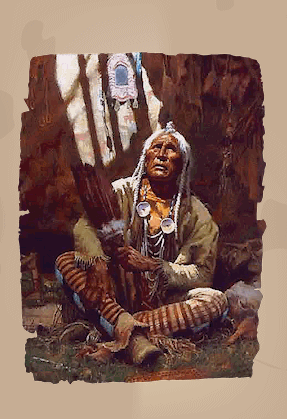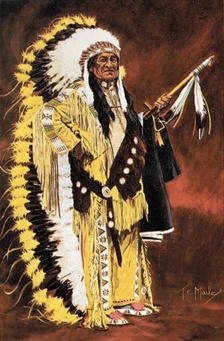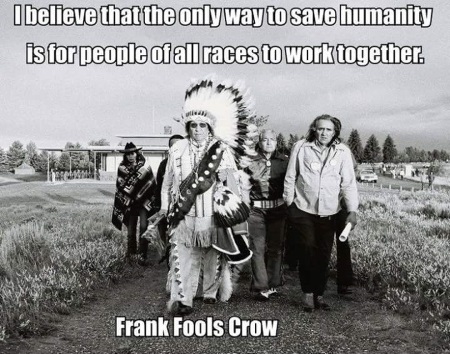Holy People
Unlike western cultures, where people choose whether or not they want to become doctors, a person receives a calling to become a Holy Person or medicine person. Sometimes this ability runs in families, and other times one naturally feels summoned to enter into this work. John Grim, author of Patterns of Religious Healing Among the Ojibway explains that the term Holy Person refers to a practitioner, from an indigenous culture, who has had an exceptional experience of the cosmic power that pervades the world. These individuals are able to bring this power into rituals to affect healing experiences.

Often healers experience some illness in their youth that leads them to be withdrawn and introspective, and causes them to seek out their advice of an elder. The person will become reflective and begin to feel a special obligation towards the work of helping others. This is a tremendous responsibility. A person must develop and maintain a special relationship with the spirit world, and bring that special relationship with spirit to the person or situation in need.
Many times, the Holy Person will receive revelations concerning particular objects to be used in rituals. These can vary and may include something from nature, a song, or a combination. Items can accumulate over a period of years, and are known as medicine bundles. But medicine bundles are seen as more than material objects; they are a collection of experiences. More specifically, these represent encounters with the sacred world that have been revealed through particular objects.
Medicine bundles are very personal and private, and meaningful only within a cultural context. Grim notes that it is inappropriate for non-Native peoples to place medicine bundles in museum out of curiosity, as these are an integral part of tribal identity and transporting them from a people would inflict deep wounds upon their heritage and identity. Besides, outsiders can never fully appreciate their significance. However, it may be appropriate for non-Native people to try and understand the significance of medicine bundles to Indian cultures to increase an awareness and respect for their customs and traditions.
Plants play an important role among medicine objects. Many indigenous healing practitioners had a profound understanding of local plant life based on a sacred classification. In other words, they understood how one should approach a plant, which parts of which plants are to be used for treating specific maladies, and the idea of reciprocity, respecting the plant as a being of equal worth, being thankful for its help, and leaving an offering, such as a prayer, for the plant that is taken. A deep intimacy of exchange exists at all times.
The understanding of how a Holy Person functions is difficult for people of western cultures to understand, as their views of the world are so different. Yet it is something most people today need and yearn for. Grim explains: "What makes the Holy Person's role so fascinating, in the late twentieth century, is the cosmological setting in which a Holy Person functions, namely, Holy Persons bring people into the presence of the spirit beings who are in the world and in the cosmos. This is something very beautiful. It's so difficult for us to understand in mainstream America where our cosmology, for the most part, is either the story of Genesis or the story of science. While the Genesis story is seen as very meaningful for Christians who hold that as their cosmology, it does not have the immediacy of entry into their daily life. It's a cosmology which tells where the world came from, and perhaps explains early parents, the fall, why women suffer in childbirth, and why we were driven out of the garden. But it is not a cosmology that brings spiritual presences to our lives today. It's a story that explains. The scientific cosmology is also an explanatory story, but one without interest in sacred or spiritual meaning. Scientists are reflective, but they work within certain limits. Their cosmology is a description of the world as it appears to them through their empirical observation.
"We live in this world, then, where the cosmologies that are available to us provide no intimacy. And yet we experience constant intimacies with this seasonal world, with this world of resources, with the clothes that we wear on our back. I want to suggest that the human is constantly interacting with this world. And our interaction demands some respect and attention. That attention can be trivialized or it can be deepened. And Holy Persons are personalities who live in deepened relationship with their cosmology, and who assist their people to deepen their own personal and community relations with the world around them.
"We yearn for that in mainstream America. We yearn for intimacies of exchanges with our world. Does that mean we become Native Americans? That's a foolish thought. It means we need to recover our own cosmology. Well, what is our cosmology? I think that's what we need to re-explore. We yearn to recover that Holy Persona presence, that capacity to literally draw healing capacities from an exchange with the world around us, to literally heal our communities. Environmental degradation is woven right into these questions we're talking about. One reason why Native people are connected with this issue is that they have intimacies with their homeland. They have regard for that mountain, desert, body of water. When one reverences something, quite often one doesn't trash it. So, these natural exchanges between a people and the life setting in which they find themselves, those individuals called Holy Persons, I tend to see as a mode or way of being that all people are being called to recover. We are being called to bring this sense of wonder back into our daily lives. So, the Holy Person journey is not simply someone sitting with a drum, or a group of people withdrawing and taking drugs in order to get into some altered state. The Holy Persons personality is a challenge to the late twentieth century to recover right relationships with our bioregions, to begin to understand the earth again as something that has always nourished us. It will continue to provide for us. But it also needs our care and concern. That is the Holy Person ritual now."



 Holy man lived by "hollow bone" philosophy - by
Holy man lived by "hollow bone" philosophy - by 
